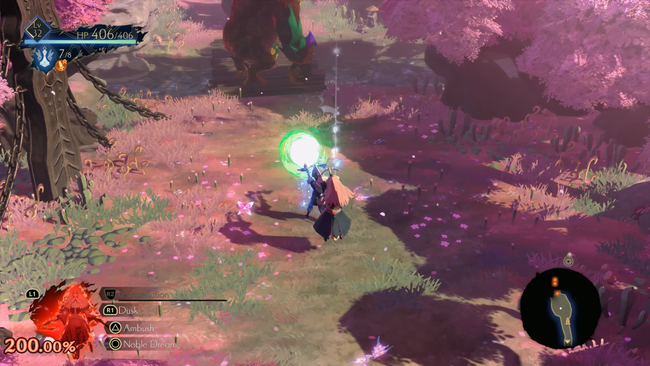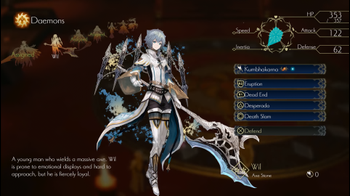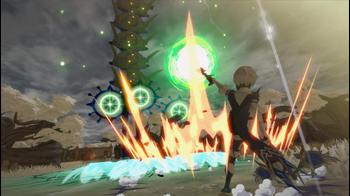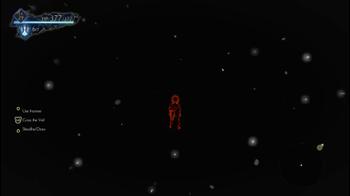Oninaki Review
Square Enix’s Tokyo RPG Factory studio hasn’t had the most spectacular start to their track record in their mission to recreate the feeling of what made older JRPGs special. I found I Am Setsuna charming, yet riddled with flaws and Lost Sphear didn’t catch my interest. Instead of another turn-based RPG this time around, Oninaki immediately sets itself apart as a full-on action RPG. Sadly, I don’t think the third time’s the charm for Tokyo RPG Factory either.

Oninaki is almost a good game. There are a lot of entertaining systems to fiddle with, but playing through the game constantly feels like a slog. I actually think Oninaki’s greatest strengths lie in its atmosphere and world-building; its melancholic tone is a nice contrast to the energetic upbeatness in other RPGs.
There’s a compelling concession that builds the foundation of Oninaki’s setting. It delves into the notion of reincarnation - with a peculiar wrinkle. When a person dies with lingering regrets, they become lost souls in the Beyond, Oninaki’s purgatorial land of the dead. That’s where the main character, Kagachi, steps in as a member of the Watchers. These Watchers are a sort of militaristic supernatural investigator that works to ensure that the deceased can pass on peacefully into reincarnation.
Oninaki’s narrative wrinkle wrestles with a society stripping away the concept of mourning by law, because mourning makes it that much harder for the dead to move on. If the dead linger around the Beyond for too long, they eventually turn into monsters. The game provides an intriguing case study of how that takes its toll on people and many of Oninaki’s sequences examine that through various angles.

I quickly caught on that Oninaki doesn’t shy away from depressingly heavy matters. If you’re someone who is especially sensitive to stories surrounding familial deaths, Oninaki may be a game you want to hold off on. Oninaki isn’t afraid of making its players feel uncomfortable. Kagachi’s journey to uncover the mysteries of Linne and the Night Devil have frequent instances of individuals struggling to cope with the death of a loved one and that may lead to disturbing sequences.
Most of the game's story beats were portrayed effectively up until the final third of it. There are certain twists and revelations that come to pass where the storytelling quickly drops off a cliff. What starts out as a promising development turns into a needlessly padded out string of exposition dumps right near the last stretch. There were a handful of times where I thought I was reaching the end of the game, but yet it kept going... and going.
The ending had me wishing that it tied itself a nice knot 10-12 hours prior to it; there were other lucrative opportunities to put a bow on the storyline without needing to resort to padding. It’s a frustrating thing to see. Once players complete the game, a new area opens up and it'll restore their characters back at the final save point so they can finish up any sidequests they may've missed. Oninaki is an emotional rollercoaster if you stick with it and believe me, that might be easier said than done.
Few games have left as bad of first impressions on me in recent memory as Oninaki did. The very opening section of the game immediately highlights some of my core gripes with it. As a member of the Watchers, Kagachi can summon forth Daemons for battle. These Daemons possess him with their own unique weapons, skills, and stats. Oninaki’s first few hours are a slow ramp that emphasizes how terribly sluggish combat feels. It’s a standard hack n’ slash that locks what makes other action RPGs fun behind other mechanics.
Canceling a dash into an attack, for instance, is locked behind a Daemon’s skill tree. All Daemons have their own unique skill tree so you’ll need to unlock a similar corresponding ability for each and every one of them if you want to use it when they’re out. You can also have Kagachi utilize the Manifest super-mode that lets you cancel freely for a limited amount of time as well. Since there’s no universal lock-on system to focus on specific enemies, Kagachi will be frequently whiffing attacks as you try and finetune where he’s facing.

Bigger weapons can also be a problem for the game’s performance too. Shortly after I got a Daemon wielding a gigantic axe, I swung it at a massive group of little enemies and realized the massive mistake I made. Higher damaging weapons often have a more severe hit-stop when they make contact with a foe; needless to say, my PS4 Pro was chugging just to complete the axe’s wide swing cleaving into them.
Mobility options are also restricted to whatever Daemon you have summoned. You start off with a swordswoman that can dash around, and soon after you obtain a spear-wielding knight that can jump. Kagachi will never be able to dash and jump freely since these actions are all tied to Daemons and at the start of Oninaki, switching between Daemons takes a few seconds. Daemon switching is a bit more instantaneous after unlocking it in their skill tree, yet it’s not as fluid as I wanted it to be. There’s no way to really switch Daemons mid-combo or combine Daemon’s abilities that may have synergy. Put simply, everything feels too slow.
After accepting to meet Oninaki on its own terms, the battle system does become fun after unlocking more toys to play with. There’s a variety of Daemons you’ll obtain throughout the game and they do all feel pretty unique. Figuring out which Daemon would be the most effective in disposing of certain enemy types felt rewarding. Most boss encounters are freeform enough to let you fight them the way you want to.
I appreciated that each Daemon has their own backstory that gave them a bit more personality. They’re not involved in the main tale and their backgrounds are sectioned off as parts in their skill tree. After unlocking and viewing these chunks, their skill tree expands. It’s a shame that the Daemons’ story segments came off underproduced; they all consist of the Daemons monologuing to themselves in a blank white space. The Daemons just simply stand there reflecting on their past life for a few minutes.
Daemons are fairly robust when it comes to customization. Loot drops from enemies so higher rarity and slotted weapons come into play. There’s a crafting system to upgrade and equip them with stones that modify a wide assortment of factors. For example, each shot from my ranged Daemon had a chance to inflict enemies with both poison and stun. The Daemons’ skills also have a chance to awaken when they’re used, which grant them further enhancements. It’s a lot of small subsystems that slightly alleviate my problems with the combat - but not nearly enough to absolve it from them.

Another significant issue I ran across in Oninaki is traversal gradually becomes a chore. There’s a decent amount of environmental variety throughout the game, though the map layout themselves are dull. You’ll find yourself running across narrow corridors to some wide-open field sections until the next save point - gradually inching closer to the next story marker. Oddly enough, none of the maps make use of a Daemon’s mobility options. I would’ve thought that environmental puzzles would be a natural fit for it; only one long dungeon section really has any sort of a puzzle and it’s a poor one.
If you’re a map completionist or treasure seeker, constant backtracking is a prevalent issue in Oninaki too. Kagachi has the ability to travel between the Living World and the Beyond at almost anytime. Traversing the Beyond isn’t quite possible until you defeat a Sight Seeker in the Living World which will open up that section of the map to be explorable in the Beyond. If you try to explore the Beyond without a Sight Seeker opening it up first, it’ll be a pitch-black void space that’ll have enemies one-shot you in it. Different locations apply a different modifier for being in the Beyond as well, such as the first hit of an attack absorbing HP or slowing your movement speed.
The Beyond comes with its own benefits since it’s the primary place where you’ll find treasure chests and side quest NPCs. Your map completion, unfortunately, doesn’t carry over between the Living World and the Beyond which further leads progression to feel like a slog. You’re essentially exploring each space in the game twice. Phasing in-between the Living World and the Beyond is also not as fast as I want it to be. There are a few creative situations for it though, mainly to retreat from difficult enemies in either realm or positioning yourself to a more advantageous position before you phase in. It’s another one of many systems in Oninaki that has potential to be something good, but falls short of it.
When all is said and done, I’m torn on Oninaki. It’s close to being greater than the sum of its parts, yet it falls apart in its execution. A lot of Oninaki’s mechanics sound great on paper and the game never manages to fully realize them in a cohesive way. I think there are parts of Oninaki that are enjoyable to play and those don’t surface until much later into the game. My playthrough lasted roughly 25 hours long and it never manages to shake off the slow combat flow. Oninaki’s story initially starts out as its compelling saving grace and Tokyo RPG Factory sadly botches it down the line. It's frequent and long loading times doesn't do it any favors either. There’s a bundle of good ideas in Oninaki that could’ve made it a great game… and it was almost there. Almost.